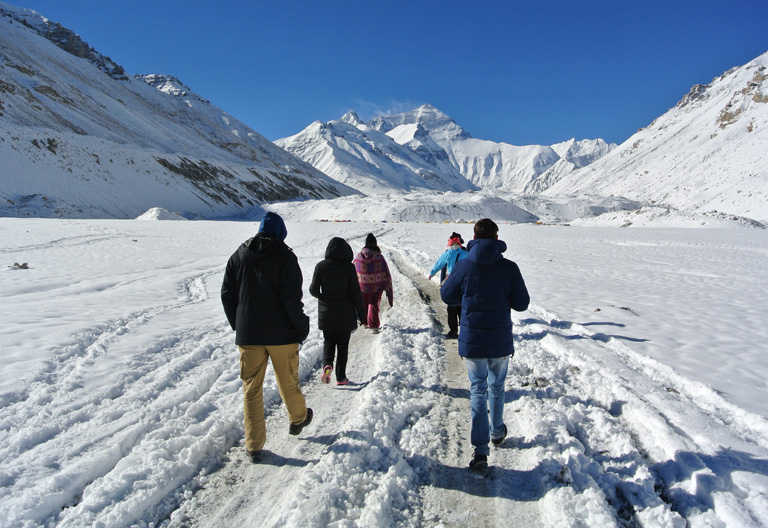Starting: Old Tingri (Shegar Town)
Finishing: Everest Base Camp (north face Tibet side)
Difficulty: Moderate to difficult
Distance: 70km (43.5miles)
Duration: 3~4 days
Highest elevation: Pang-la Pass (5350m)
Accommodation: Camping
Best time to trek: Apr to Oct
Nearest city: Shigatse
DAY 1: Old Tingri Town to Lungchang
4~5 hours / 12km / 150m Ascent
After obtaining admission ticket of Everest National Park at Old Tingri Town, you will start today’s
trekking to Lungchang Village, which is manly on plains and valleys, and usually costs about 4~5 hours. Today
you will walk at slow pace to adjust yourself to the high altitude and thin air. About half of today’s
trekking will be done in the beautiful Ra-chu Valley where you can enjoy vast meadows with herd. You will also
pass by several Tibetan villages whose people mainly make living on herding. The route partly follow a bumping
earth road which allows vehicles passing, and partly take straight paths in the valley. Today’s highest
point is a pass with altitude of 5170m. Getting over the pass and pass by a small Tibetan monastery, you will
arrive at the campsite of today – Lungchang (4510m).
DAY 2 Lungchang to Lamna-la
7~8 hours / 21km / 200m Ascent
Today you will trek from Lungchang to Lamna-la. It is a challenge of both energy and mind because you will
walk many strenuous trails while you leave the lower Lungchang to ascent to the high pass of Lamna-la (5150).
Remember to walk at a moderate pace and take some necessary rests on route because it is a long trek. Today
you will also see several villages and the highest-altitude primary school in the world. Yes, you are not
along on this high land in shadow of Mount Everest. After all the efforts you will get your feet on the
Lamna-la Pass, and enjoy the breathtaking scenery. From this pass, you have chance to see four of the highest
peaks in the world – Mount Everest, Makalu Peak, Cho Oyu Peak and Shishapangma Peak. Last, find a good
location to camp and have a good rest.
DAY 3 Lamna-la to Zommug
7~8 hours / 22km / 360m Descent
Today you will trek about 15km from Lamna-la to Zommug Village. The first half is mainly downhill trail which
is verdant with a variety of plants. There are many yaks on the hills. Then you will see many white corrals
environing expansive plains, which means you are about to get Zommug Village. The plains here are too
infertile to grow the Highland Barley. So the only way to make a living is to count on their yaks and sheep.
As you approaching Zommug, you can also see the giant Mount Everest and Gyachuang Kang Peak in a distance.
This night, camp near Zommug Village.
DAY 4 Zommug to Everest Base Camp
7~8 hours / 15km / 290m Ascent
Today’s trekking goes along a boulder-strewn valley leading to Rongbuk Monastery and EBC without sharp
ups and downs. The altitude will increase gently to 5200m at Everest Base Camp. After about 12km’s
trekking, you will arrive at the highest monastery in the world – Rongbuk Monastery, and get a wider and
closer sight of the mighty Everest. Located about 5100 meters above the sea level, Rongbuk Monastery is the
highest monastery in the world. It is the best location to take some great photos of the front face of Mount
Everest. Take a short rest at Rongbuk Monastery, you will then keep trekking to EBC. The distance from Rongbuk
Monastery to EBC is about 8km, approximately 2 hours’ walking. You will walk to EBC and spend some time
enjoying the closer view of Mount Everest, then take a park bus back to Rongbuk Monastery area for camping.
















 Karen
Karen Wonder
Wonder Jack
Jack Rita
Rita Johnson
Johnson Vivien
Vivien Wing
Wing Ariel
Ariel Leo
Leo Tracy
Tracy Evelyn
Evelyn April
April Phoebe
Phoebe Kelly
Kelly Shirley
Shirley Reya
Reya Juliet
Juliet Elk
Elk Felix
Felix Sean
Sean